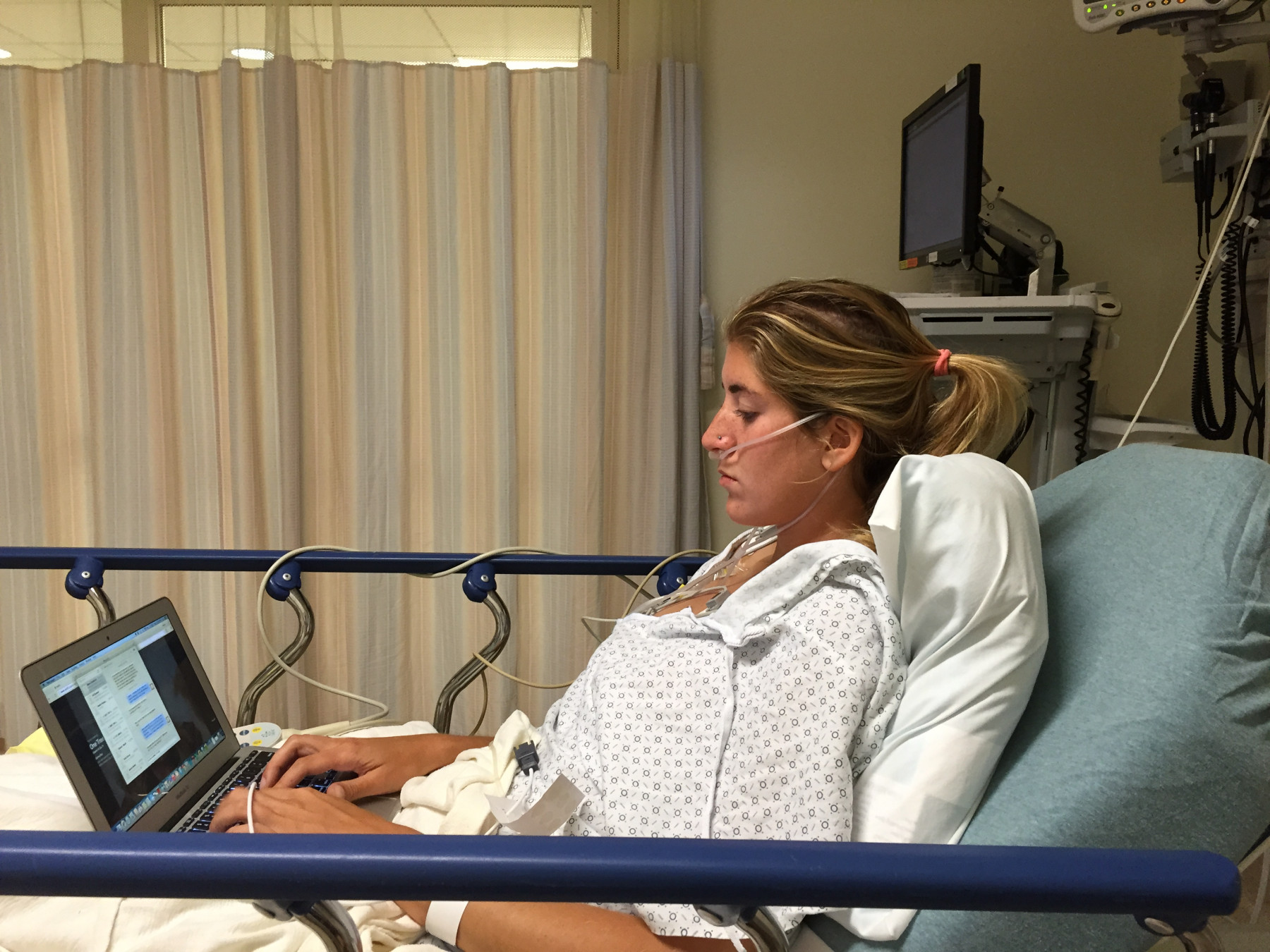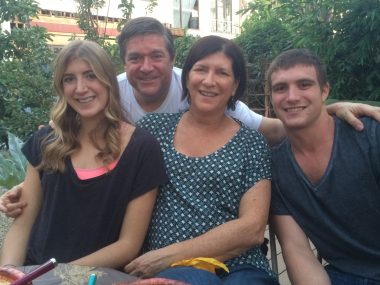‘Salt in My Soul’ Now a Film About Mallory Smith’s Life With CF

Mallory Smith in Will Battersby's "Salt in My Soul." (Photo by Giant Pictures)
Mallory Smith was a poster child for cystic fibrosis (CF). She was a three-sport varsity athlete in high school, was accepted into Stanford University, and was consistent with her therapies, medications, and nutrition. Her smile and positive energy were felt by friends and family.
On the inside, however, no one — not even her mother — understood the struggles she faced. Smith was forced to stay home or endure long periods of hospitalization when she wanted nothing more than to travel the world, write about ecology, and photograph the natural environment.

Photo poster of the film “Salt in My Soul.” (Photo courtesy of Giant Pictures)
All her thoughts, dreams, and frustrations were laid out in a series of journals she kept on her computer from age 15 to 25 — and some handwritten entries written as early as age 9. After Smith died post-lung transplant from an antibiotic-resistant superbug, at her direction, the password to access all the journals was given to her mother, Diane Shader Smith.
Shader Smith published her daughter’s work in a posthumous memoir, “Salt in My Soul: An Unfinished Life.” It shared the inner feelings of a young woman dealing with a disease that was slowly killing her.
Now the book has been turned into a documentary of the same name slated to premiere in select theaters in L.A. and New York City Jan. 21, and on video-on-demand platforms Jan. 25. It follows Smith through interviews and family videos as she battles CF, from diagnosis at 3 years old to her death in 2017 at age 25.
“I think that in her wildest dreams, she would never have envisioned that the world would want to see a documentary about her. And I would say, for me, that’s the hardest part,” Shader Smith said in a video interview with Cystic Fibrosis News Today. “But, that said, she did have something to say, and she did want her messages to be out there.”
The 96-minute film paints a detailed picture of Mallory, her life, and her resilience in dealing with CF, including percussive therapy, extended hospital stays, and giving up her dreams of traveling to focus on her health.
It features interviews from friends, doctors, family, professors, and her boyfriend Jack Goodwin, all of whom were touched by her life. Smith also is seen reading excerpts from her diary, some of which have not been shared with the public until now.
In the last moments of Mallory’s life, the documentary also captured a novel phage therapy that came too late for her, but since has saved the lives of others battling superbug infections.
All money made from the film after release will go to Mallory’s Legacy Fund, which supports clinical research into antimicrobial resistance, including the Burkholderia cepacia superbug that invaded her newly transplanted lungs.
“I think this documentary does a great job of showing what cystic fibrosis has historically done to so many people,” said Gunnar Esiason, 30, executive vice president of strategy and advocacy for the Boomer Esiason Foundation and a CF patient, in a video interview with CF News Today. “Mallory had such an eloquent way of describing what was happening to her as she lived through it, and I think it’s such a gift that we have access to her journals, or even her voice really, to understand what it was like.”
Esiason, son of former pro football player Boomer Esiason, has been taking a cystic fibrosis transmembrane conductance regulator (CFTR) gene modulator called Trikafta for three years. Trikafta combines three drugs — elexacaftor, tezacaftor, and ivacaftor — to correct the folding of the faulty CFTR protein and hold the transmembrane channel open to allow salts to pass through. He has not had a transplant and is healthy, he said.
Smith was in a similar clinical trial for Ataluren (since discontinued after failed Phase 3 studies), which had seemed to be helping. But because of an episode of hemoptysis, or coughing up blood, she was pulled from the trial.

From left: Mallory Smith, Mark Smith, Diane Shader Smith, and Micah Smith. (Photo courtesy of Giant Pictures)
Will Battersby is the director of “Salt in My Soul.” He said the documentary, at its core, is a coming-of-age story that may be a familiar foundation for viewers. But Battersby said it also allowed him to broach difficult topics such as mental health and invisible and chronic illnesses.
“I think if we hadn’t had that really cinematic story at its center it wouldn’t have felt so easy to watch,” Battersby said of the flowing narrative when interviewed by CF News Today.
“Salt in My Soul” shows Smith’s positivity, but it also pulls no punches regarding the difficulty of living with CF. Near the beginning, a home video depicts a very young Smith doing percussive therapy to clear her lungs. “It hurts,” she says in between the vibrations of her vest, which replicates manually hitting the chest to knock mucus free. In another instance in the latter half of the documentary, Battersby includes a recorded audio argument between Smith and her mother about missing a few percussive therapy treatments.
While much of the film is devoted to CF, Battersby said that everyone can take something away from it, especially with the added anxiety felt by the COVID-19 pandemic.
“What’s so beautiful about this story right now, is that that specificity really can become a metaphor for what so many people are going through,” Battersby said. “Mallory’s story is … it’s OK to suffer and then you move on.”
While the documentary spends most of its time on Smith’s journey, Shader Smith said other important themes emerge, such as phage therapy and treatments that attack antibiotic-resistant bacteria. Mental health is another one, as Smith was diagnosed with depression in college.
It also touches on the parallels between human sickness and environmental erosion. The saltwater of the Pacific Ocean, where Smith spent so much time living in Los Angeles and traveling to Hawaii with family, has been shown to have benefits for CF patients. She also wrote a book, “The Gottlieb Native Garden: A California Love Story,” with conservation photographer Susan Gottlieb, who was interviewed in the film.
Battersby, and the production studios 3 Arts Entertainment and Reno Productions, have been working on the film since the fall of 2019. Shader Smith, while not directly involved in production, was a “sounding board,” Battersby said, and she’s used her public relations background to help promote the film.
The interviews for the film were done in February 2020. Battersby had wanted to include more, but COVID-19 restrictions interfered. It meant he and his editor, April Merl, would have to be more creative in telling the story. A lengthy video interview with Mallory after college, done by a choreographer who incorporated her audio into a dance, also surfaced during production.
Battersby and Merl worked for nine months after these interviews, tediously piecing together segments of Mallory’s video interview, audio recordings of her journal, family footage, and b-roll (supporting scenes used to provide context and continuity for the main story). The final cut was ready in early 2021; however, it wasn’t complete until March. Reno Productions and 3 Arts Entertainment then sold the film to distributor Giant Pictures.
Toward the end of the documentary, Battersby focuses on the final effort to save Mallory’s life after bacteria colonized her lungs post-transplant. Her father, Mark Smith, discovered that bacteriophages potentially could destroy Burkholderia cepacia, as they had done naturally for thousands of years. However, by the time Mark discovered this treatment pathway and phages grown by the Naval Medical Research Center and Adaptive Phage Therapeutics were flown to Mallory at The University of Pittsburgh Medical Center, where she had received her transplant, it was too late.
Since then, with the help of Smith’s book and the upcoming documentary, Shader Smith has traveled the country speaking about phages and sharing Mallory’s story. As of May 2021, Shader Smith said, her family has raised more than $5.5 million for CF research. She said she’s already raised $100,000 by sending out a trailer of the film to the CF community.
Other CF patients are now benefiting from phage therapy and the treatment is becoming more mainstream.
“My purpose is to give something back within my lifetime,” Smith says in the documentary. “I used to envision that in a lot of different ways and now I think that you can make a difference in big and small ways.”
It appears Mallory Smith continues to do just that even in her physical absence. Her life story is now being read and watched by the world.








